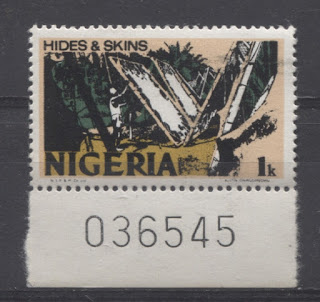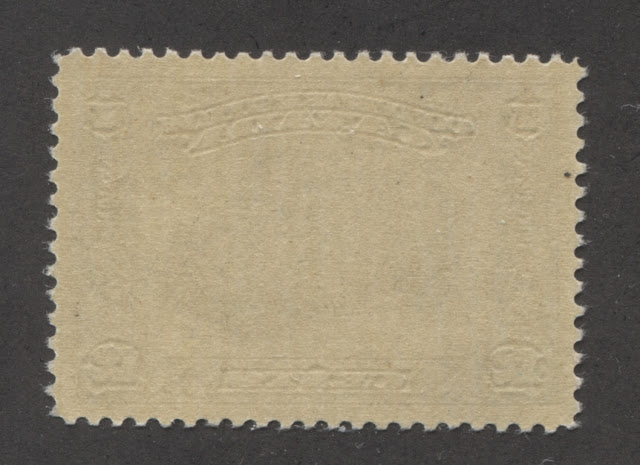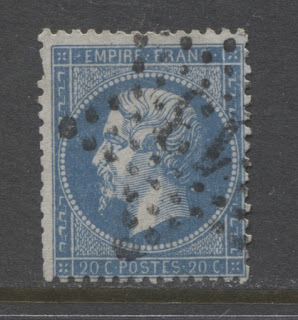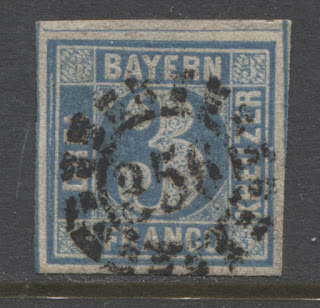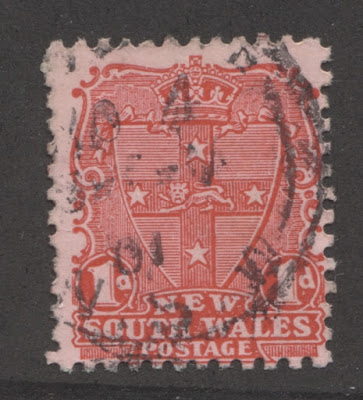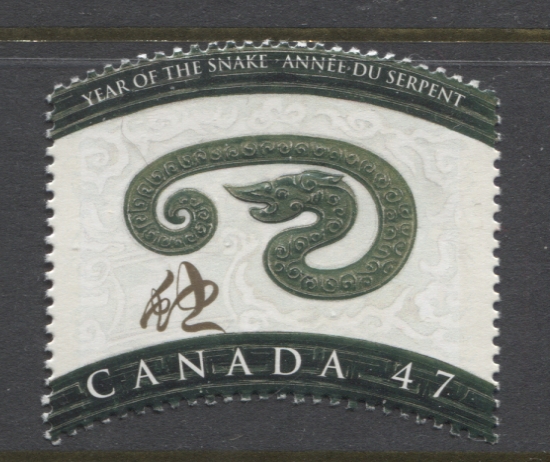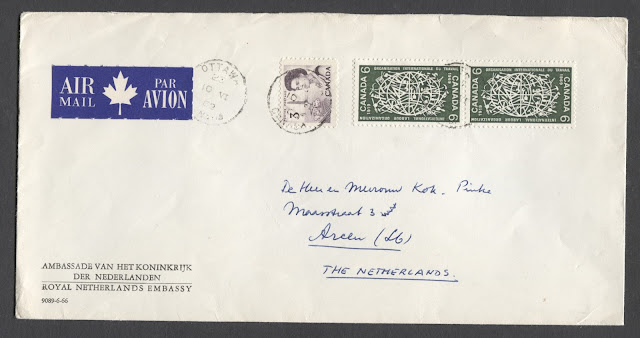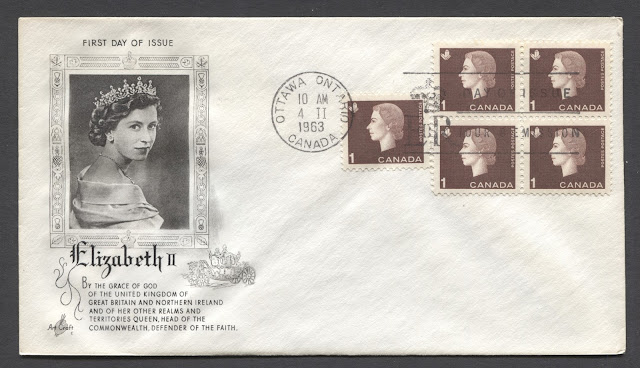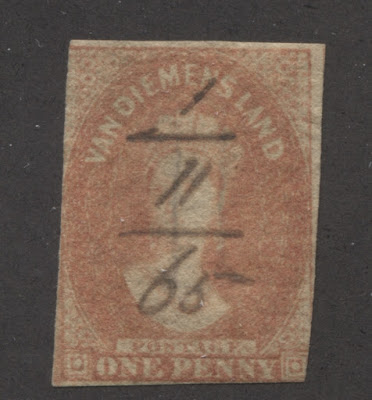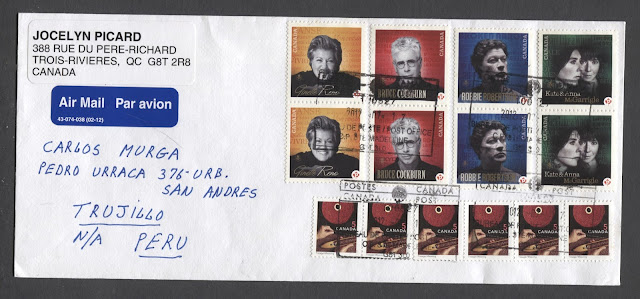Definitive Stamp
Philatelic Glossary - Terms Beginning With "D" to "F"
A definitive stamp is a stamp issued for regular, utilitarian postal use, and is often in use for many years before being replaced by a new series. Definitives usually depict the ruler of the country, but they can also depict a common theme, such as fish, plants, or industries, like the 1k Nigeria stamp shown above, that was issued in 1973. Most stamps that are issued in booklet form are definitives, with that trend changing in recent years as many countries have begun to issue commemoratives in booklet form as well.
Dextrine Gum, Dextrose Gum or Gum Arabic
The substance on the back side of the stamp that allows it to be fastened to the envelope, is called the gum. Up until the late 1960's and early 1970's, stamp gum was made with dextrose - a cellulose based, natural substance. Such gum was often very shiny, yellowish and had a flavour that many found unpleasant. The 1927 Confederation stamp shown above is an example of this type of gum. Some countries that produced this gum also added other compounds which caused it to attack the paper it was on, resulting in damage to the stamps if not removed. Germany during the 1930's is an example of a country that did this by adding sulphuric acid to the gum.
By the late 1960's synthetic alternatives in the form of Polyvinyl Alcohol, also known as PVA gum became available and started to come into general use. However, there are still many countries, most notably France, that have continued to use dextrine gum on their stamps up to the present day.
Diamond Dot Cancellation
A cancellation which consists of a pattern of dots arranged in a diamond is known as a diamond dot cancellation. This type of cancellation was quite popular in France and the French colonies during the 19th century. most often, this cancellation would have a series of numerals at the centre of the diamond, which would correspond to a particular postal office or district to which it was assigned. Many specialists collect these quite eagerly and some of the cancellations are quite rare, though many are common.
Diamond Star Cancellation
Another form of cancellation that was popular in France and its colonies during the 19th century was the dotted Diamond cancellation. These consisted of a star made up of small dots. Some of these had numerals in the centre, such as the first one shown above, while others did not. Like other forms of numeral cancellations that were in use during the 19th century, the numerals corresponded to a specific post office, and many specialists collect them.
Die Cut
The the term "Die-Cut" refers to a method of separation used for modern self-adhesive stamps, in which a cutting mat is laid over the stamps, and perforations are cut into the stamps, so that they can simply be peeled apart from their backing individually. In recent years, postal administrations have moved away from printing stamps on gummed paper, so that perforating has become obsolete, and perforated, gummed paper stamps are gradually being replaced by self-adhesive die-cut stamps. The above image shows pair of die-cut stamps issued for the Tall Ships Visit to Halifax for 2000. The die cutting is very visible at the top and bottom of the pair, but much harder to see between the two stamps, due to the nature of the stamp design.
Dividing Line
Many imperforate issues of early European countries had coloured lines printed in the margins between the stamps that were either solid or dotted, which were intended to serve as a guide as to where to cut between the stamps so as to obtain a full stamp. Such lines are known as dividing lines. Generally speaking, the very best premium examples of these stamps will show either full dividing lines, or traces of dividing lines on all four sides, as this means that the stamp has full sized margins on all four sides. British Commonwealth issues from this period do not generally show these lines however, so it becomes much more difficult to tell if a stamp has full sized margins, or close margins. Generally in these cases, you have to be familiar with the plate characteristics of the specific issue to know what the normal spacing was between stamps and thus, what constitutes "full margins". On some issues, particularly from Thurn and Taxis (a German State), full margins can be very, very small: as little as 1/4 of a millimeter. On other issues, such as New South Wales diadem stamps, the margins can be very wide, with 3 mm margins being common.
Doubly Fugitive Ink
The term "fugitive" as applied to ink means that the ink will run and fade with exposure to certain solvents. When ink remains unaffected by water, an aqueous solvent, but runs when exposed to mineral solvents like turpentine, it is said to be "singly fugitive". However, when ink is fugitive upon exposure to water or any form of moisture, it is said to be "doubly fugitive".
Most of the low value definitive stamps issued during the 19th century, such as the halfpenny stamp from Barbados above were printed from singly fugitive ink. The colour of this stamp is the standard deep dull green colour that was common to most green stamps printed by De La Rue for the British Commonwealth at that time. However, once the value of the stamps rose above two pence, De La Rue began to use either doubly fugitive inks for the entire design, or a combination of singly and doubly fugitive inks. The idea was that if anyone attempted to clean the stamps for re-use, they would fade so badly as to be instantly recognizable to the postal authorities as having been tampered with. For the stamp on the left, which was issued by Great Britain for Queen Victoria's Golden Jubilee in 1887, De La Rue used doubly fugitive ink for the green colours and singly fugitive for the carmine frames. The stamp shown here is close to the original green colour, but has begun the fading process, having been briefly exposed to water. When the fading is complete, the centre colour is usally a very bright and greenish yellow. Most used examples of the stamp on the left that one sees are this colour, and have little to no value.
Another example of doubly fugitive ink is shown below with a stamp issued by New South Wales at the turn of the 19th and 20th century:
At first glance it looks like the stamp is printed on pink paper. However, this stamp was only ever issued on white wove paper. The colour has come from the ink, which has just started to run from the brief exposure to water that occurred when the stamp was soaked.
Duplex Cancellation
A duplex cancellation is one that consists of two components, placed side by side. Usually on the left, there will be a circular date stamp (CDS), and then there will be a barred oval killer on the right. Duplex cancellations have been around since the 1850's and postal regulations at the time they were introduced generally required the postmaster to apply the handstamp in such a way that the killer would fall on the stamp, and then the circular date stamp would fall onto the letter, where it could be easily read by the postal clerks. This is the main reason why CDS cancelled stamps from the 19th century are so scarce: because they weren't supposed to exist, and only came about due to carelessness on the part of the postal clerk who was cancelling the mail. This is most prevalent on the stamps of early Great Britain, where 99% of used stamps that you run into are very heavily cancelled with killer cancellations, and are consequently over very little value. Catalogue prices for early used Great Britain are for stamps that are generally in the top 1-2% of all surviving examples. Most of those unfamiliar with stamps are not aware of this, and most inherited stamp collections contain early Great Britain used stamps that are worth much, much less than their owners think.
Embossed
Embossing is a process, whereby a part of the paper is pressed through a narrow opening to produce a raised design in the paper, called a relief. The snake of the above stamp is raised from the surface of the rest of the stamp. If you turn the stamp over, there will be a large depression where the snake is. Embossing was first used on the 1847 stamps of Great Britain, and then very rarely after that, until the Cameo designs of Gambia were issued in 1869. Since then, embossing has been used to print many modern stamp issued, although it is usually employed in combination with other printing methods. For example the 2001 Year of the Snake stamp above was printed using both lithography and embossing.
Extension Hole
Most sheets perforated by either the line, or comb methods had the perforations extending right through the selvage of the sheets, all the way to the edge. However, some perforating combs were designed in such a way as to end right at the intersection with the next row or column of perforations, or they would end one hole beyond this. For example, if you look at the above pair of stamps, you will see that the bottom horizontal row of perforations ends exactly where it meets the right column of perforations. However, the vertical columns of perforations extend just past the bottom row of perforations by just one hole in each column. This extra hole is known to philatelists as an "extension hole".
The block below shows the more common scenario where the selvage is fully perforated through:
It is not at all uncommon to find situations with many definitive issues, especially those issued over a period of more than 5 years, where all three perforating methods were in use at different times, and the only way to tell the stamps printed using each method apart is to collect position pairs, singles or blocks with attached selvage, showing how much of the selvage is perforated. It is a highly specialized aspect to collecting that only a small minority of collectors get involved in, but it represents another dimension along which you can likely broaden your existing collection. It may be worth paying closer attention to your blocks to see if you can spot any such differences.
First Class Mail, Second Class Mail and Third Class Mail
First Class refers to the standard mail stream with normal delivery and handling times. Envelopes which were not marked in any way and sealed at the flap on the back are referred to as "first class letters". The distinction is lost today because the only option in most cases for sending a letter is first class.
However, until about the early to mid-1970's cheaper second and third class options also existed. Mail sent in this manner was often required to be marked "second class mail" or "third class mail" and in some cases you were not permitted to seal the envelope. Apart from this, the main difference between first class and these two options was that the delivery time was slower. By the mid to late 1970's these services were generally abolished, though some countries still have a bulk rate which businesses sending out very high volume mailings can take advantage of.
First Day Cover
A first day cover refers to a cover that was sent on a stamp's first day of issue. Most first day covers until the 1970's were produced by private individuals who would take an envelope and print, draw or paint a design onto the envelope, called a cachet, address the cover to their customers and then take them to the post office where the issue of the day would be affixed and cancelled with the first day of issue postmark. Of course any cover at all, even those without cachets that happened to be used on a stamp's first day of issue would qualify as a first day cover, and as a matter of fact it is these covers that today are the most valuable and highly sought after. However, some of the hand-painted cachets can also be worth many hundreds of dollars each, even on what is normally a very inexpensive issue.
By the 1960's larger companies started producing first day covers, with standardized, pre-printed cachets, The Art Craft first day cover above is one such example. Then in the 1970's the postal authorities themselves began mass producing their own first day covers. These are of extremely high quality and their existence essentially killed the market for individual cachet-makers who simply could not compete with the economies of scale that were enjoyed by the post office.
Fiscal Cancellation (AKA Revenue Cancellation)
Although separate stamps were often issued by most countries to evidence the payment of various government fees and taxes, called revenue stamps, many countries used the same stamps for both postage and revenue purposes. This is why the inscriptions on many British Commonwealth stamps from before 1970 are inscribed "Postage and Revenue". However there were some colonies like Tasmania, where postage stamps were frequently used for revenue or fiscal purposes, but the stamps are only inscribed "postage". The cancellations on these stamps usually indicate which type of function the stamp served.
Most postal cancellations from this time were usually a date stamp of some sort, or a barred numeral. However, when stamps were used fiscally, the cancellation was usually either a pen cancellation in the form of just the date, or a cutting device was used to score both the document and the stamp affixed to the document to cancel it. Generally speaking, except in a few rare instances, a pen cancellation that consists of nothing more than a date, like the one above is a fiscal or revenue cancel.
Revenue cancellations are generally very common where they exist, and their value is usually less than 10% the value of a postal cancellation. Sometimes, the difference in value is even more dramatic, like less than 1%. This is a very common source of contention for those trying to sell collections of British Commonwealth stamps that have been passed down from older generations. Often, they contain high value stamps, especially from British Africa, which have been used fiscally rather than postally, and whose value is minimal, relative to what the owner thinks they are worth.
Fluorescent Paper
Until the 1960's most stamp paper was produced from wood pulp that had no whitening agents added. Such paper would appear dull greyish or even darker under an ultraviolet lamp. The stamp on the bottom row in the above picture is how most stamps printed prior to the 1960's looked under ultraviolet light.
Then, starting in the late 1950's and early 1960's, paper manufacturers began adding whitening agents to papers or started using fibres which had been bleached. Under ultraviolet light these papers glow with varying degrees of brightness from quite dull to extremely bright bluish white. The stamps in the upper row all contain varying degrees of whitening agents. The brightest of these are known to philatelists as highbrite or hibrite paper.
Frameline, Spandrel, Vignette and Value Tablet
All stamp designs, with very few exceptions are contained within an outer line, or group of lines. This outer line or group of lines is called the frameline (s). Usually, but not always , a stamp will have both an outer frameline, and an inner one. The above stamp from Lagos issued in 1894 has both an outer frameline, that surrounds the entire design, and an inner one that surrounds most of the design as well.
The main portion of the design within the frame and frame ornaments is called the vignette. On the above stamp, the vignette is the bust of Queen Victoria. The corner portions of the design that lie outside the vignette, but within the framelines are called spandrels. The leaf ornaments on this stamp in each corner are the spandrels on this stamp.
The space enclosing the words of value (denomination) is called the value tablet. It is usually rectangular, although it really can be any shape at all.
Franking
The term "franking" refers to the combination of stamps that has been affixed to a cover to pay the postage.

